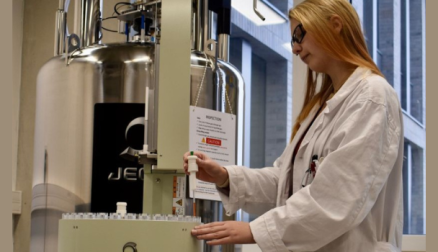
NMR spectroscopy – the key to revealing the structure of substances
At the Department of Chemistry, Faculty of Science, UJEP, our equipment includes a JEOL NMR spectrometer, which was put into operation at the end of 2020. This state-of-the-art device allows us to determine the structure of substances in both liquid and solid phases and is used across various fields of chemistry – from inorganic to organic and biochemistry.
At the heart of the spectrometer is a superconducting magnet connected to a radio frequency unit. Samples are inserted into the probe at the bottom of the device, where they are automatically tuned. The device is also equipped with a robotic sample exchange system with a capacity of up to 32 positions, enabling efficient and continuous operation.
NMR spectroscopy utilizes the properties of atomic nuclei and can provide accurate information about the arrangement of atoms in molecules. We use it, for example, to confirm the structure of substances created by chemical synthesis. Our measurements include one-dimensional spectra of common and less common nuclei (e.g., ^1H, ^13C, ^19F, ^29Si) as well as two-dimensional correlation experiments that allow us to link information about different types of nuclei.
The method is universal—it does not distinguish between organic and inorganic chemistry—and is one of the basic tools of modern chemistry. Its importance is also demonstrated by the fact that three Nobel Prizes (1952, 1991, and 2002) have been awarded for the discovery and development of NMR.
🎥 Watch the video and find out how NMR helps us “see” molecules.